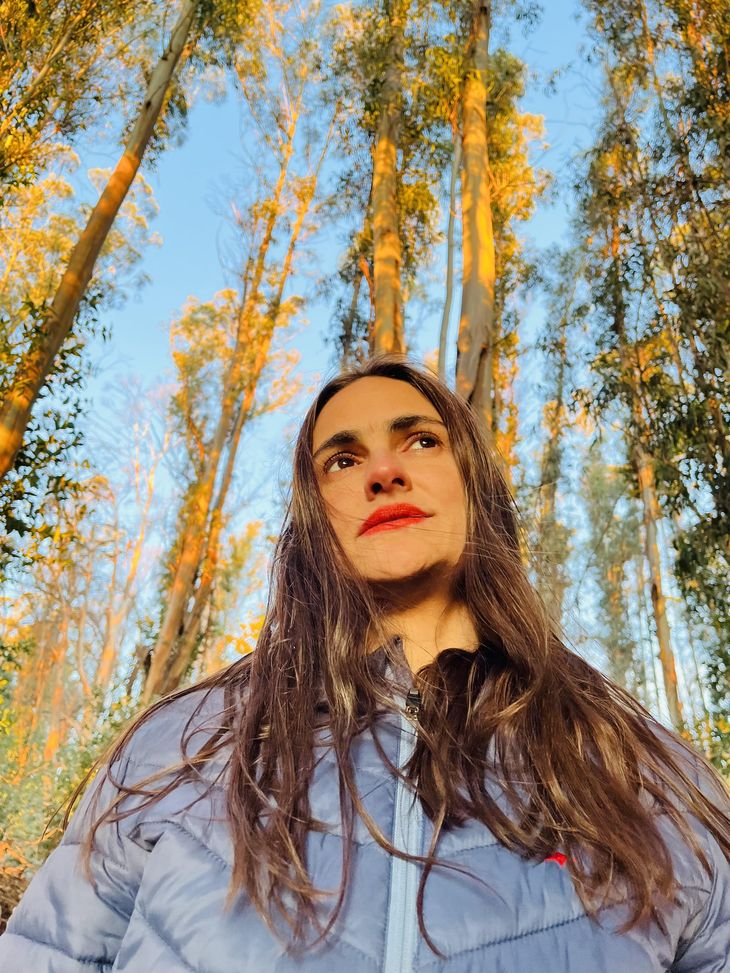“This album that I present, ‘La citadina’, has to do with something very personal. It was born from a force of inspiration in nature, in that which exceeds the city”says Carla Pantanali to this newspaper. “You see the sunset, a flock of birds passing by; surely the avenue below is jammed, but above it the birds fly. I feel called by that nature, but always within the urban. To say ‘city woman’ is to underline that contrast. A woman in the city who connects with the naturalness that exists within it.”
Pantanalcomposer, singer, guitarist, actress, theatre teacher, has established herself as an inescapable figure in the national scene, both musical and dramatic. Granddaughter of two illustrious figures of our show, Luis Sandrini and Malvina Pastorinohis name has long had its own weight, beyond the pride that his grandparents and his mother inspire in him, Sandra Sandrini. Among her most recent theatre performances is her acclaimed role as Portia in “Brutus”at the Payró Theater.
During August, Pantanal will present his first CD live, with the addition of some new songs, on two occasions: Tomorrow Saturday 3rd at 5pm at Pista Urbana (Chacabuco 874, San Telmo) with Jerome Guiraud on guitars, Nico Fernandez on double bass, Pablo Grinjot on piano and Miguel Vilca in charango, and the Saturday 24th at 7:30 pm at the Museum of Contemporary Art (Av. San Juan 328), with Juan Kiss as a guest musician on clarinet.
In our conversation, we begin by choosing the word that defines the album.
carla photo nature.jpeg
Carla Pantanali, a singer who seeks connection with nature from within the city itself
Journalist: It’s not the citizen but the city-dweller. Of course, saying ‘citizen’ refers more to the civic, almost in a Roman sense (like in the times of Porcia and Brutus). But there is also ‘urban’. Does the choice of a word that coincides with the Italian one have something to do with its Genoese ancestry?
Carla Pantanali: No, it is actually a concept that makes a difference, also the expression of a longing, that of connecting with slower rhythms. “I can hear what comes from far away by opening my eyes from within,” says my song. It is always aiming to connect.
Q: It’s the spirit of a song but it defines the whole album.
CP: Exactly. That’s what I came to after deciding to put together the repertoire. Some of those songs are many years old, and I realized that they were all composed by me from a place that has to do with connecting with life from a different, genuine place, connected to the body and to the nature that I myself am. There is, for example, a song dedicated to the birth of my second daughter, which I decided to do with a natural birth in water, and to turn to the ancestral knowledge that my body has. About my first daughter there is another song called ‘Inventar un mundo’, and it has to do with the longing of that city woman who feels contaminated by this world, this city that is also contaminated. The city woman raises daughters to love the earth, to greet the sun and connect with what is not usually perceived in the urban. And it’s not that I did it on purpose. Years went by, and when I put together the bunch of songs that make up the album I was surprised that they all spoke a little about the same thing.
Q: Looking out from the city but without escaping it.
CP: Just like that. I can look up and notice that the sunset I’m looking at is unique, that there never was nor will there be another like it.
Q: It is not a rejection of urban noise, in the manner of Fray Luis (“What a restful life is that of he who flees the worldly noise”), but rather a modification of the gaze.
CP: That’s right. Even the cover of the CD reflects that. You can see me standing on the dome of the Santa Rosa de Lima church in Montserrat, 65 meters high (they took a photo of me with a drone). There I am looking at the sunset that day, and the city surrounding me. That image sums up what we are talking about: I am in the city, but looking at everything that is bigger than the city, that exceeds it, that has another time, another pulse, another rhythm, but always with my feet on the asphalt.
CP: How long did the album take to form?
Q: The oldest song must be about ten years old, and since then I have been composing the rest until they form a unit. There is also a cover; there are seven of my songs and a cover of Charly García, “No soy un extraño”.
porcia.jpeg

The actress in her recent performance as Porcia at the Payrò Theatre.
Q: I know that the pandemic also influenced the decision to release the album.
CP: Yes, during that time my different artistic facets came together and I felt that I had to give them a joint outlet. I had Covid-19, and that was when I decided to release my album. I had trained as a musician and worked as an actress. And at that moment I put everything together: today I feel fulfilled as an artist, and I made that decision while having Covid.
Q: As a composer, does this continue in the same vein?
CP: Yes, it is inevitable. Although I am not talking specifically about nature, but about a profound way of perceiving what life is, the miracle in which we are immersed, and to think about this you have to stop and observe: the things that I can name are everywhere, but my songs do it in a different, unconventional way. There is something philosophical. It also has to do with gratitude, appreciation. That is what my new songs lead me to.
Q: Speaking of philosophy, you once mentioned pantheism.
CP: Yes, I consider nature an expression of God
Q: Paradoxically, the philosopher par excellence of pantheism, Baruch Spinoza, one of Borges’ favourites, was an atheist. And that is precisely why he was accused of not believing in a personal God, who only manifests himself in the elements of nature. This is at the same time affirming that he denies God.
CP: (smile) That’s not my case. On the contrary, if anything happened to me when I was older, it was that I began to believe in God. All that nature with which I seek to connect is, for me, a manifestation of his existence.
Q: How are your songs stylistically defined?
CP: It is an urban song that mixes different genres: there are rock songs that have a zamba aroma; at times the matrix of candombe appears. There is also a jazzy air in another song. It is the condition of the urban song: we are crossed by many genres that shaped those of us who were born in big cities.
Q: And folklore?
CP: Folklore has enriched me greatly. Not when I was very young, but it was something I acquired. As a child I listened to classical music, the Beatles, then rock pops like Spinetta or Charly, but later, already studying music, I approached folklore, first through Cuchi Leguizamón, the zambas from the north, the Cuyo song, the tonada, Corrientes and its chamamé. That appears in La Citadina, not as a chamamé, because I can’t do it because I’m not from there, but I take the rhythmic cell as a Rioplatense composer.
Source: Ambito
I am an author and journalist who has worked in the entertainment industry for over a decade. I currently work as a news editor at a major news website, and my focus is on covering the latest trends in entertainment. I also write occasional pieces for other outlets, and have authored two books about the entertainment industry.




